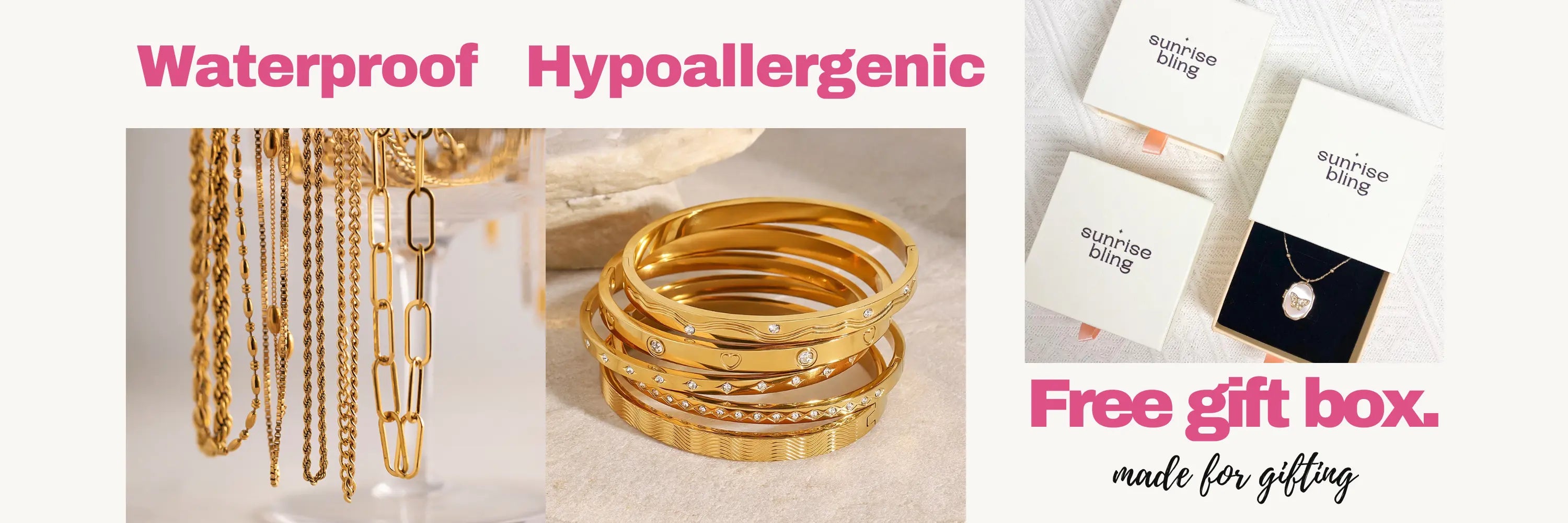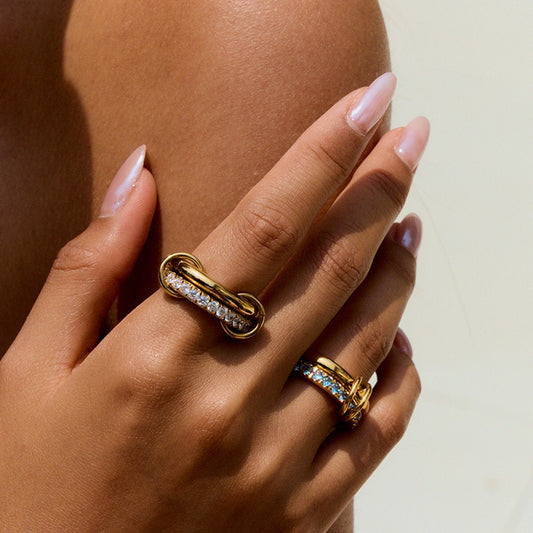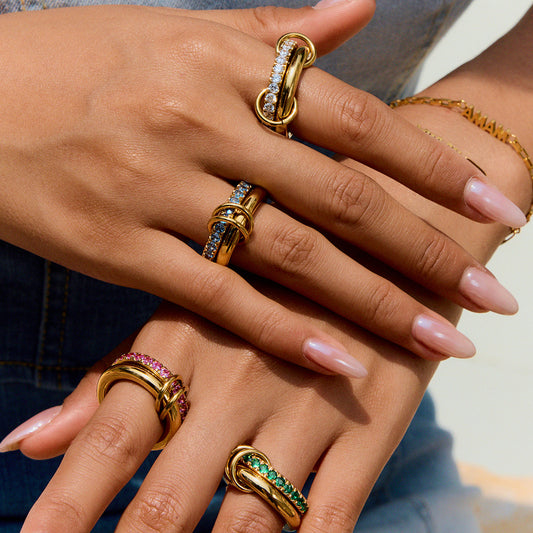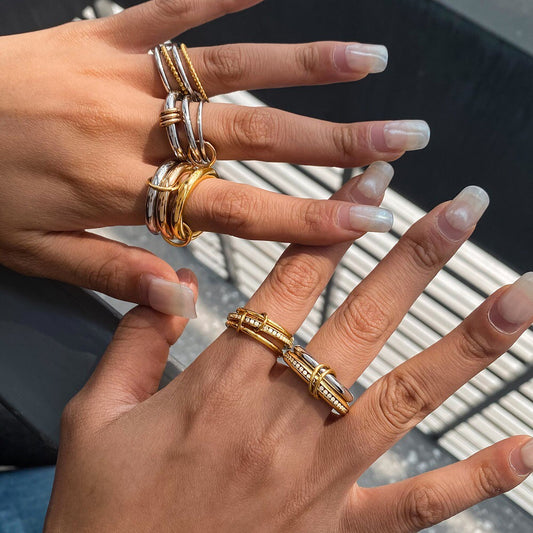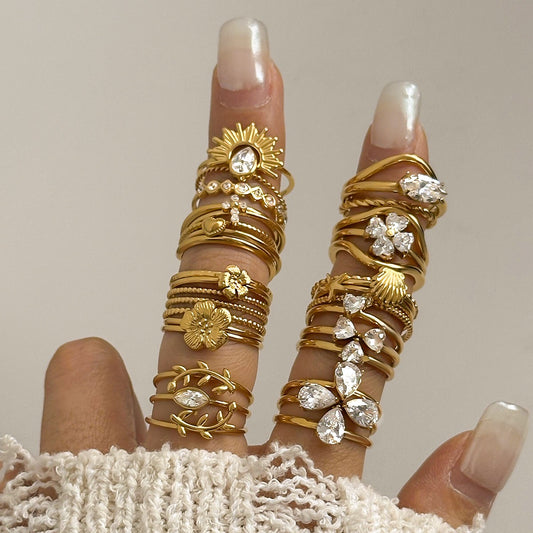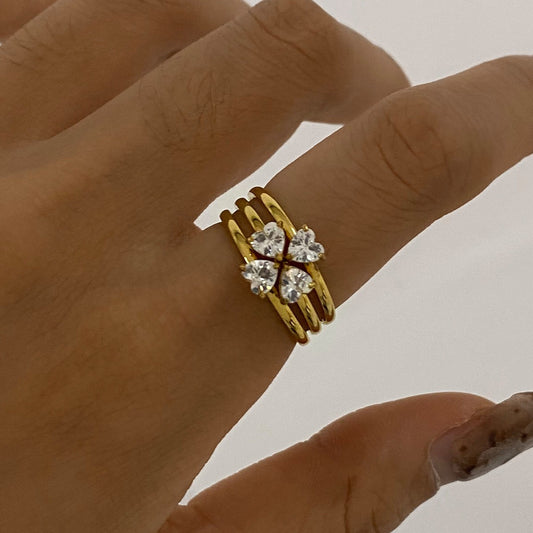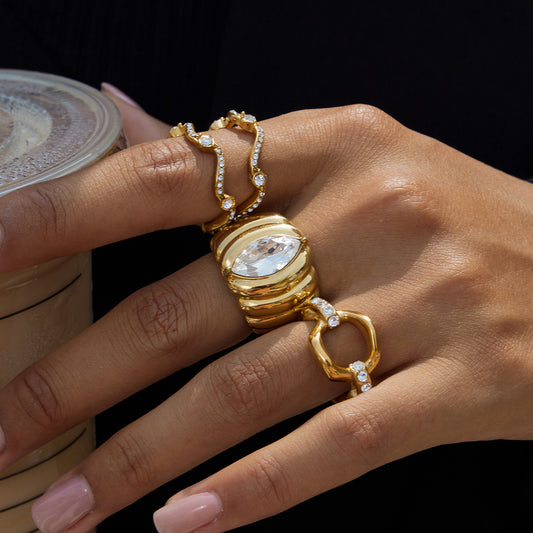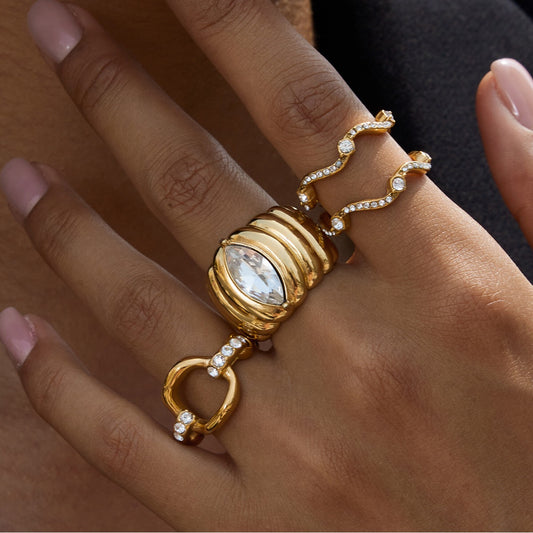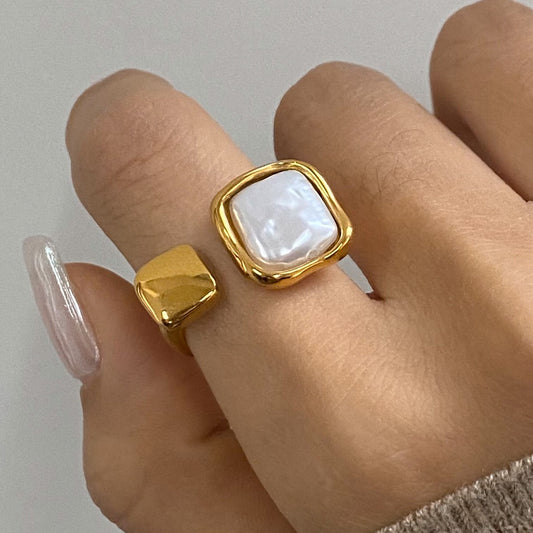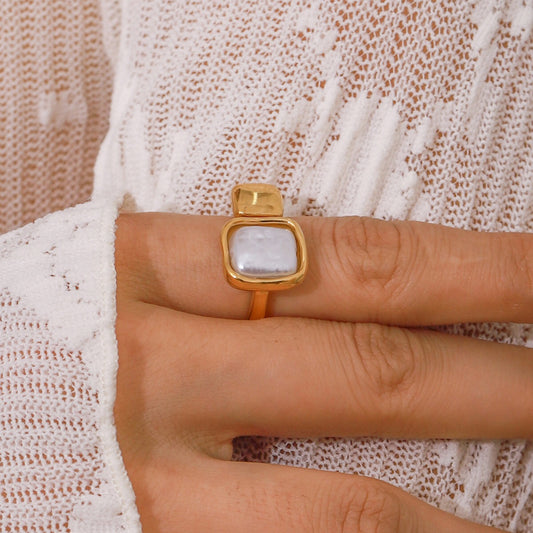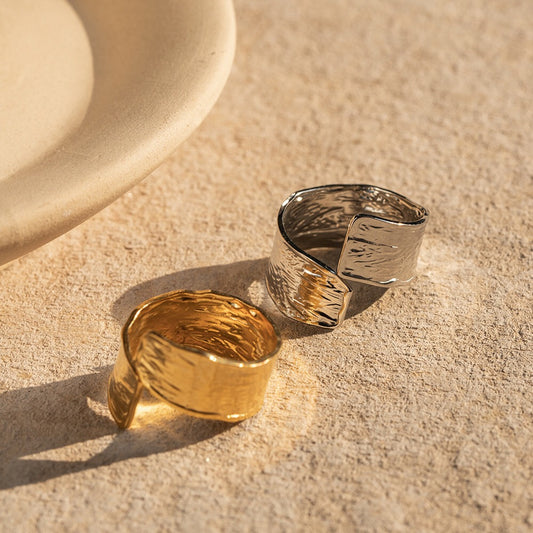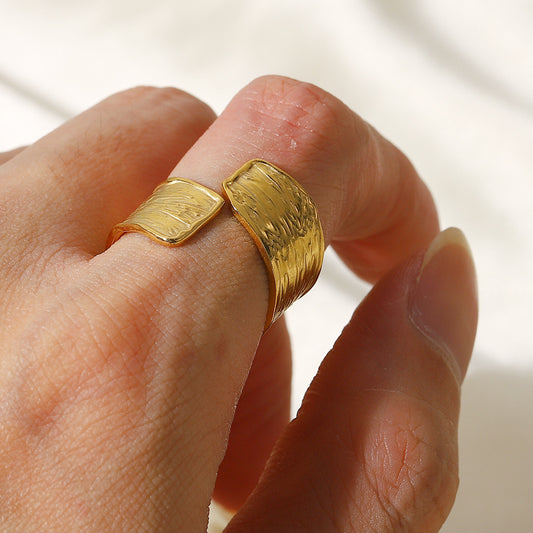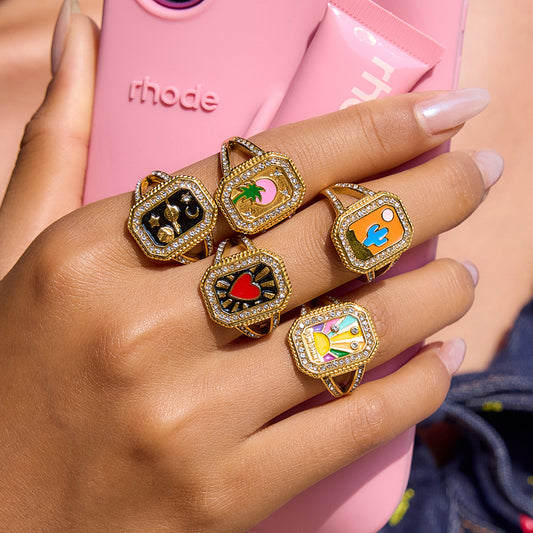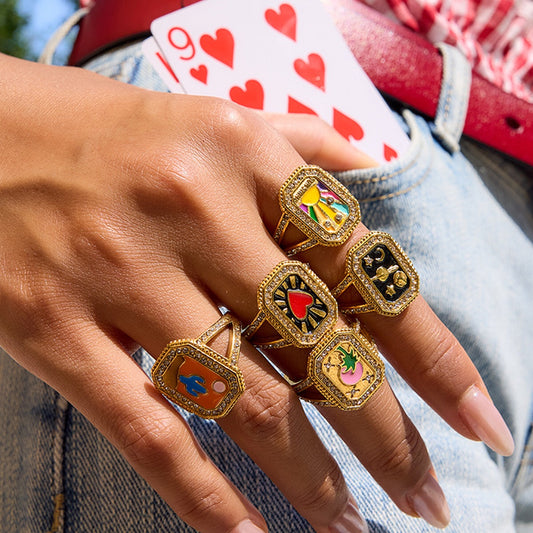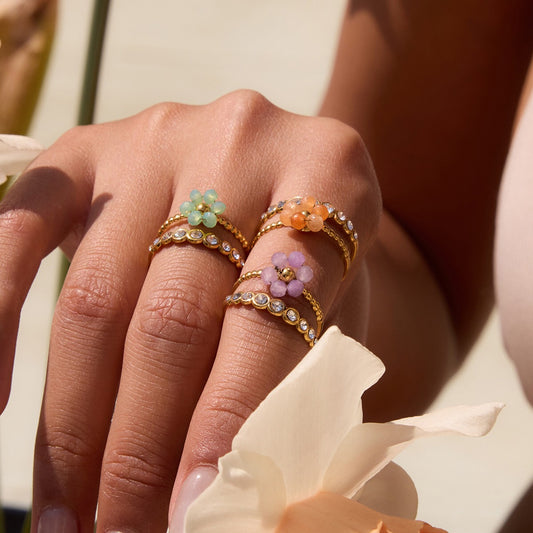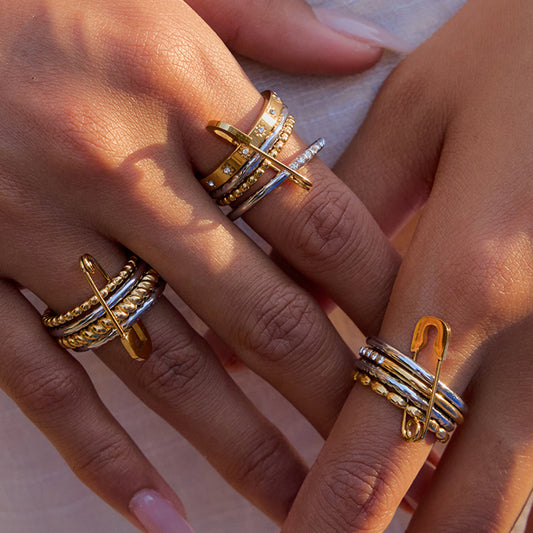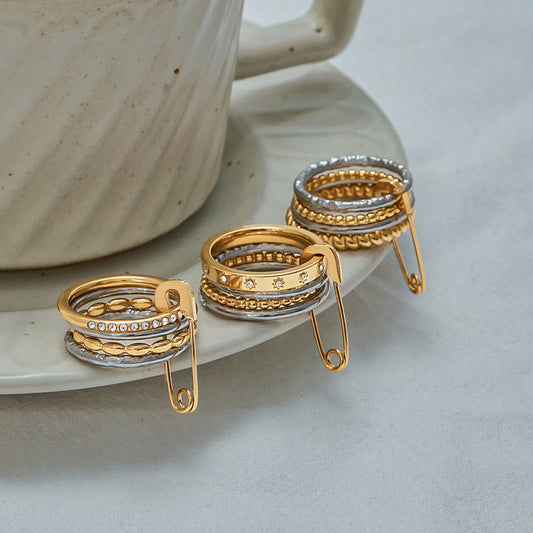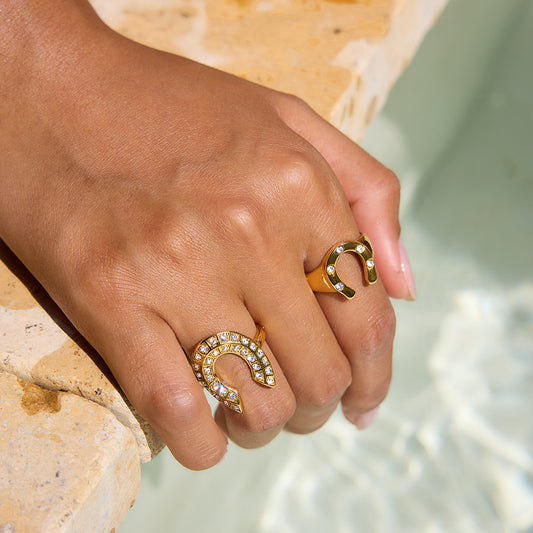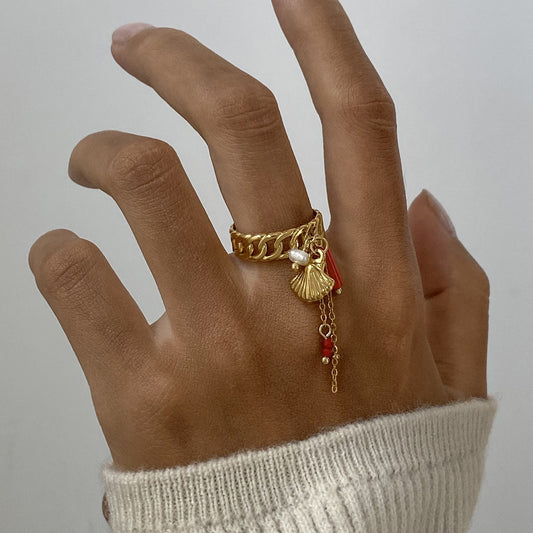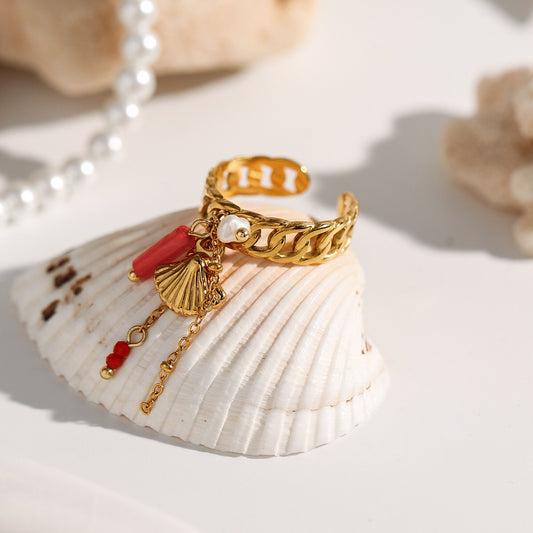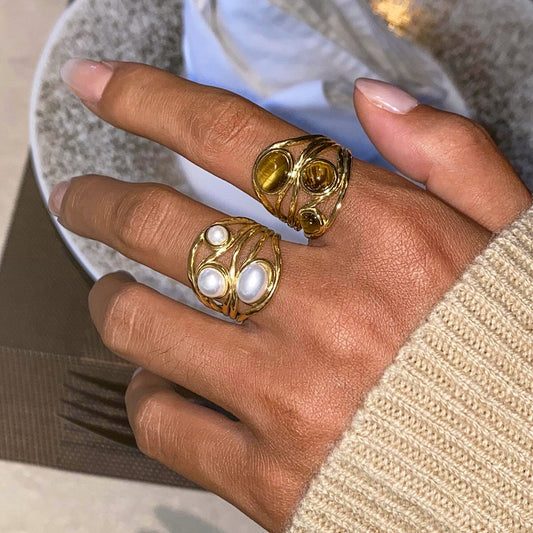Sapphire ring has long been a symbol of luxury and timeless style, but today it’s more than just a “royal” accessory—it’s a versatile staple for everyday wear. Sapphire Jewelry Market size is estimated to be USD 10.5 Billion in 2024 and is expected to reach USD 15.2 Billion by 2033 at a CAGR of 4.9%. What makes them so beloved? Their rich, velvety blue hue adds a pop of color without being over-the-top, and they’re durable enough for daily use—unlike more delicate gemstones like emeralds. From solitaire styles to stackable bands, a sapphire ring works for coffee runs, work meetings, and anniversary dinners alike. This guide covers everything you need to know about sapphire rings, from their origin to why they’re the perfect gift for your wife.

What Is a Sapphire Ring?
A sapphire ring is a piece of jewelry featuring a sapphire gemstone (natural or lab-grown) set in a metal band (like gold, silver, or platinum). Sapphires are part of the corundum mineral family—second only to diamonds in hardness (rated 9 on the Mohs scale), making them ideal for everyday wear. While most people associate sapphires with deep blue, they actually come in a range of colors (pink, yellow, green, and even colorless), but blue sapphires remain the most popular for rings.
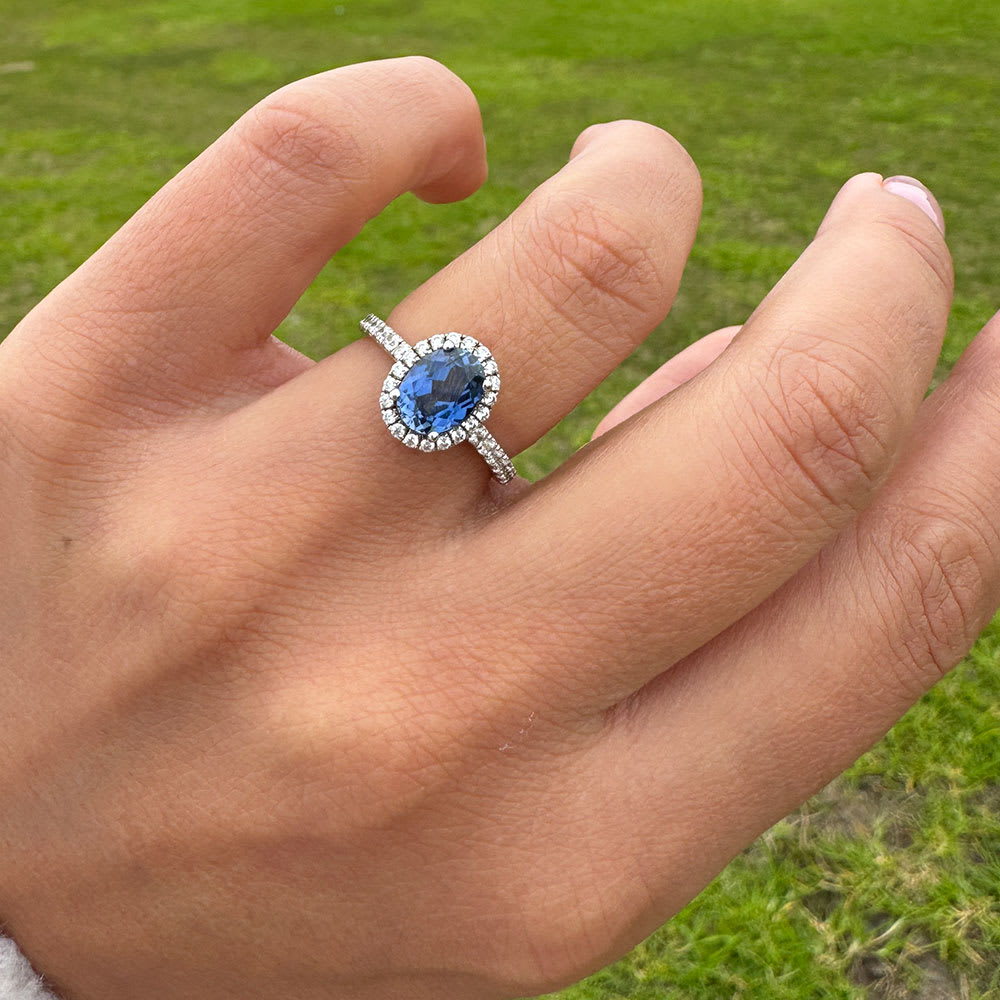
Key Characteristics of Sapphire Rings
-
Sapphire Types: The two main categories of sapphires used in rings are:
-
Natural Sapphires: Mined from locations like Sri Lanka, Myanmar, and Montana, valued for their rarity and unique color variations. They’re graded by color intensity (the deeper the blue, the more valuable), clarity (fewer inclusions = higher quality), and cut (which enhances their brilliance).
-
Lab-Grown Sapphires: Created in a controlled lab environment, chemically identical to natural sapphires but 30–50% more affordable. They have the same hardness and color as natural sapphires, with fewer inclusions (making them more consistent in quality).
-
Metal Bands: The band material impacts both style and durability:
-
White Gold (14k/18k): A popular choice for blue sapphires, as its cool tone complements the gemstone’s blue hue. It’s hypoallergenic and resistant to tarnish.
-
Yellow Gold (14k/18k): Adds warmth to sapphires, creating a vintage-inspired look. It’s durable and pairs beautifully with deeper blue sapphires.
-
Platinum: A luxury metal that’s scratch-resistant and hypoallergenic. It enhances the sapphire’s color without fading, making it ideal for heirloom-quality rings.
-
Sterling Silver: An affordable option for casual sapphire rings (e.g., stackable bands). It’s hypoallergenic for most people but may tarnish over time (easily polished with a silver cloth).
-
Setting Styles: How the sapphire is attached to the band affects both security and aesthetics:
-
Prong Setting: 4–6 metal prongs hold the sapphire in place, maximizing light exposure to enhance its color and sparkle. Common in solitaire sapphire rings.
-
Bezel Setting: The sapphire is encased in a thin metal rim, protecting it from chips or damage. Perfect for active lifestyles or everyday wear.
-
Halo Setting: A central sapphire surrounded by small diamonds (or smaller sapphires), amplifying its visual size and adding extra glamour. Popular for engagement or anniversary rings.
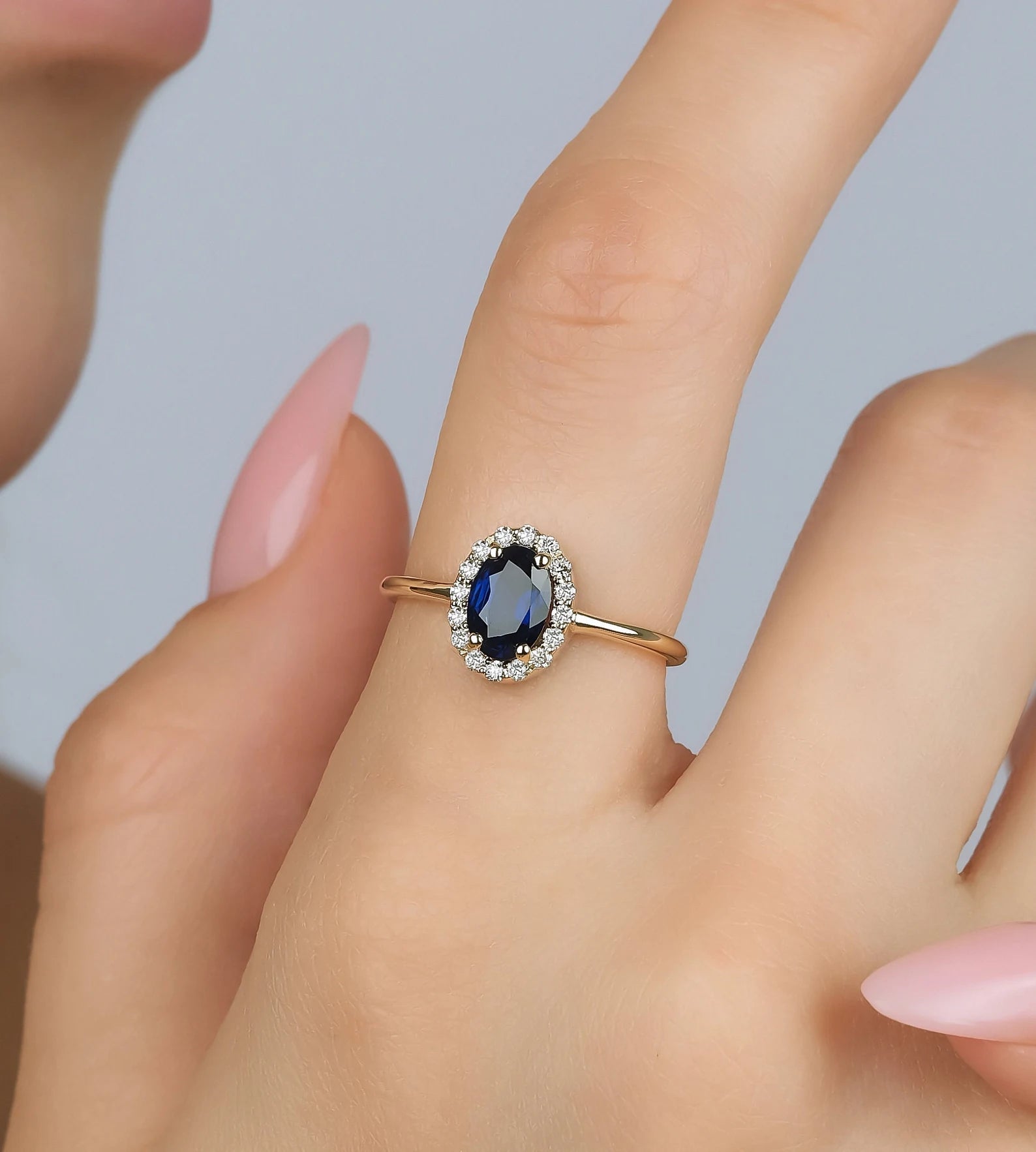
How Sapphire Rings Differ from Other Gemstone Rings
-
Durability: Unlike emeralds (rated 7.5–8 on the Mohs scale) or rubies (also 9, but more prone to inclusions), sapphires are tough enough for daily wear—they won’t scratch or chip easily.
-
Color Versatility: While emeralds are limited to green and rubies to red, sapphires come in multiple colors (though blue is most iconic), making them adaptable to different styles.
-
Symbolism: Sapphires represent loyalty, wisdom, and longevity—more meaningful than many other gemstones, which adds sentimental value to the ring.
Why Is a Sapphire Ring So Popular?
Sapphire rings’ popularity isn’t just about their beauty—it’s about their ability to fit modern lifestyles. They’re colorful but not flashy, durable but elegant, and meaningful but accessible. Their appeal boils down to four key factors:

Timeless Color That Never Fades
Deep blue sapphires have been cherished for centuries—worn by royalty (like Princess Diana’s iconic sapphire engagement ring) and celebrities alike. Unlike trendy colored gemstones (e.g., tanzanite or peridot) that feel dated after a few years, blue sapphires remain stylish. They pair with every color in your wardrobe: neutrals (black, white, gray), earth tones (brown, beige), and even bold hues (red, green).
Durability for Everyday Wear
Sapphires’ hardness (9 on the Mohs scale) makes them perfect for daily use. You can wear a sapphire ring while cooking, typing, or running errands without worrying about scratching the gemstone. This durability sets them apart from more delicate gemstones (like pearls or opals), which require careful handling.
Sentimental Symbolism
Sapphires are steeped in meaning:
-
Loyalty: They’re often associated with long-lasting relationships, making them a popular choice for engagement or anniversary rings.
-
Wisdom: In many cultures, sapphires are believed to bring clarity and insight, adding a deeper layer of significance to the ring.
-
Longevity: Their durability symbolizes a lasting bond—whether with a partner, a family heirloom, or a personal milestone.
Accessibility for Every Budget
Gone are the days when sapphire rings were only for the wealthy. Lab-grown sapphires and smaller-carat styles mean there’s an option for nearly every budget:
-
Budget-Friendly: Lab-grown sapphire stackable bands in sterling silver cost \(100–\)300.
-
Mid-Range: Natural sapphire solitaire rings in 14k gold cost \(500–\)2,000.
-
Luxury: Large natural sapphire halo rings in platinum cost $2,000+.
Popular Styles of Sapphire Ring
Sapphire rings come in a range of designs, from minimalist to bold, ensuring there’s a style for every taste. Below are the most in-demand options:

Classic Solitaire Sapphire Rings (Timeless)
The iconic “solitaire” style—one sapphire as the centerpiece—perfect for anyone who loves understated elegance:
-
Blue Sapphire Solitaire: A single round or oval blue sapphire (0.50–2.00 carats) set in a prong or bezel setting. The most popular style for engagement or everyday wear. Choose white gold for a modern look or yellow gold for vintage charm.
-
Colored Sapphire Solitaire: A pink, yellow, or green sapphire in a simple setting. Ideal for those who want a pop of color without sticking to traditional blue.
Halo Sapphire Rings (Glamorous)
These styles feature a central sapphire surrounded by a “halo” of small diamonds or sapphires, adding sparkle and visual size:
-
Blue Sapphire Halo: A 0.50–1.00 carat blue sapphire with a halo of tiny diamonds (0.10–0.20 carats total weight). The diamonds enhance the sapphire’s blue hue, making it look more vibrant. Perfect for anniversary or special occasion rings.
-
Double Halo Sapphire: A central sapphire with two layers of halos (e.g., a diamond halo and a smaller sapphire halo). It’s bold and glamorous—great for those who love statement jewelry.
Stackable Sapphire Rings (Versatile)
Thin, lightweight bands with small sapphires (or sapphire accents) designed to be worn with other rings:
-
Sapphire Stacking Band: A thin 14k gold or sterling silver band with tiny blue sapphires (0.05–0.10 carats each) set in a pavé style. Wear it alone for a subtle look or stack it with plain gold bands or diamond rings.
-
Two-Tone Sapphire Stacker: A band with a mix of gold (white or yellow) and small sapphires. The two-tone design adds visual interest, making it easy to pair with other jewelry.
Vintage-Inspired Sapphire Rings (Nostalgic)
These styles draw inspiration from past decades, blending retro flair with modern wearability:
-
Art Deco Sapphire Ring: Geometric shapes (e.g., squares, triangles) with sapphires and diamonds set in 14k yellow gold. Popular in the 1920s, this style adds old-world charm to any outfit.
-
Edwardian Sapphire Ring: Intricate filigree details (delicate metal patterns) with a small sapphire as the centerpiece. Made from platinum or white gold, it’s elegant and romantic—perfect for heirloom pieces.
How to Wear a Sapphire Ring
Wearing a sapphire ring is easy—its rich color pairs with nearly any outfit. Follow these tips to make the most of its elegance:
Styling for Casual Looks
-
Stackable Band + Basics: Wear a thin sapphire stacking band with jeans, a white t-shirt, and sneakers. Add a denim jacket and a simple necklace for a “casual chic” vibe.
-
Solitaire Ring + Loungewear: Dress up a cozy oversized sweater and leggings with a small sapphire solitaire ring. Add fuzzy slippers or ankle boots for an “elevated loungewear” look—perfect for coffee runs or casual meetups.
-
Vintage Ring + Boho Outfits: Pair an Art Deco sapphire ring with a flowy maxi dress, suede sandals, and a fringed bag. The ring’s retro style complements bohemian prints and natural fabrics.
Styling for Work Wear
-
Solitaire Ring + Professional Attire: A small sapphire solitaire (0.50 carats or less) works with blazers, button-downs, and pencil skirts. It’s subtle enough for meetings but adds a pop of color to a plain outfit. Avoid large halo rings at work—they can be distracting.
-
Stackable Band + Business Casual: For a relaxed office environment, wear a sapphire stacking band with a knit sweater, wide-leg pants, and loafers. Stack it with a plain gold band for extra texture.
-
Match Metals to Your Watch: If you wear a silver watch, opt for a white gold or sterling silver sapphire ring. If you wear a gold watch, choose yellow or rose gold—this creates a cohesive look.
Styling for Formal Occasions
-
Halo Ring + Gowns: Pair a sapphire halo ring with a floor-length gown in a neutral color (black, white, champagne). The diamonds in the halo add sparkle, making the ring the focal point of your outfit. Keep other jewelry minimal—small stud earrings and a thin necklace.
-
Vintage Ring + Cocktail Dresses: Wear an Edwardian sapphire ring with a knee-length cocktail dress and strappy heels. Add a small clutch with metal hardware that matches the ring’s band (e.g., platinum clutch for a platinum ring).
-
Colored Sapphire + Bold Outfits: If you’re wearing a bright red or green dress, choose a pink or yellow sapphire ring. The contrasting colors add visual interest without clashing.
Sapphire Ring: Perfect Gift for Your Wife
A sapphire ring is one of the most thoughtful gifts you can give your wife. It’s elegant, meaningful, and durable—making it far more special than a generic gift.
Why It Resonates as a Wife Gift
-
Symbolism: Sapphires represent loyalty and longevity—perfect for honoring your marriage. Gifting a sapphire ring says, “I’m committed to us, now and always.”
-
Personalization: You can choose a style that fits her taste: a solitaire if she loves minimalism, a halo if she enjoys glamour, or a stackable band if she prefers versatility.
-
Durability: She’ll wear it every day—unlike flowers or perfume (which fade), a sapphire ring lasts for years, becoming a reminder of your love.
Top Sapphire Ring Gifts for Your Wife
-
14k White Gold Sapphire Solitaire: A classic choice—0.75–1.00 carat blue sapphire in a prong setting. It’s versatile, durable, and matches everything she owns.
-
Halo Sapphire Ring with Diamonds: A 0.50 carat blue sapphire with a diamond halo, set in 14k rose gold. It’s glamorous enough for anniversaries but subtle enough for occasional everyday wear.
-
Vintage Art Deco Sapphire Ring: A geometric-shaped sapphire with diamond accents, set in 14k yellow gold. Ideal for milestone anniversaries (like 5th or 10th) or if she loves retro style.
Tips for Choosing the Right One
-
Know Her Style: If she wears mostly casual clothes, opt for a stackable band or small solitaire. If she loves formal events, a halo or vintage ring is better.
-
Check Her Metal Preference: Does she wear white gold, yellow gold, or rose gold? Stick to what she already loves—most sapphire rings come in all three options.
-
Consider Her Lifestyle: If she’s active (e.g., exercises often, cooks), choose a bezel-set ring (more protective). If she works in an office, a prong-set solitaire is perfect.
How to Clean a Sapphire Ring
Sapphires are durable, but they need regular cleaning to maintain their rich color and sparkle—everyday dirt, lotion, and oil can make them look dull. The good news is cleaning a sapphire ring is easy to do at home.
Daily Care to Prevent Dullness
-
Wipe After Wear: After wearing the ring, use a soft, dry microfiber cloth to wipe the sapphire and metal band. This removes skin oils and lotion that can build up on the surface.
-
Store Properly: Keep the ring in a soft jewelry pouch or a jewelry box with a padded compartment. Avoid storing it with other jewelry (like diamond rings or metal bands) that can scratch the sapphire or band.
-
Remove Before Activities: Take off the ring before showering, swimming, cooking (especially with greasy foods), or applying makeup/hairspray. Water and chemicals can dull the sapphire’s color or tarnish the metal.
Step-by-Step Cleaning Process
-
Mix a Mild Solution: In a small bowl, combine 1 cup warm water with 1 drop of mild dish soap (like Dawn—avoid bleach or ammonia).
-
Soak the Ring: Let the ring soak for 10–15 minutes. This loosens dirt and oil from the sapphire and setting (especially prong or pavé settings, where grime hides).
-
Scrub Gently: Use a soft-bristled toothbrush (or a small jewelry brush) to scrub the ring—focus on the sapphire’s back (where oil builds up) and the setting’s crevices. Be gentle around prongs—too much pressure can bend them.
-
Rinse and Dry: Rinse the ring under warm water to remove soap residue, then pat it dry immediately with a microfiber cloth. For extra shine, buff the metal band gently with the cloth.
What to Avoid When Cleaning
-
Abrasive Cleaners: Skip toothpaste, baking soda, or scouring pads—they scratch the metal band and can dull the sapphire’s surface.
-
Ultrasonic Cleaners: These machines are safe for most sapphire rings but can damage vintage styles or loose settings (they may dislodge the sapphire). Stick to hand cleaning for delicate designs.
-
Extreme Temperatures: Don’t expose the ring to hot water or direct sunlight—this can discolor the metal (especially sterling silver) or fade the sapphire’s color (rare, but possible for low-quality stones).
Are Sapphires Good for Engagement Rings?
Yes—sapphires are an excellent choice for engagement rings, and their popularity has grown steadily in recent years (thanks in part to Princess Diana’s iconic sapphire engagement ring). Here’s why they’re a great alternative to diamonds:
Durability for Lifelong Wear
Engagement rings are worn every day, so durability is key. Sapphires’ hardness (9 on the Mohs scale) means they can withstand daily use—they won’t scratch or chip easily, even after decades of wear. This makes them just as durable as diamonds (rated 10) for practical purposes.
Unique Color and Style
Sapphires offer a break from traditional diamond engagement rings, adding a pop of color and personality. Deep blue sapphires are classic and romantic, while pink or yellow sapphires are perfect for those who want something more unique. They also pair beautifully with diamonds (e.g., a sapphire center stone with diamond side stones), creating a timeless yet distinctive look.
Meaningful Symbolism
Sapphires represent loyalty, commitment, and longevity—exactly the values of a marriage. Gifting a sapphire engagement ring says, “I’m in this for the long haul,” adding emotional weight to the proposal.
Affordability Compared to Diamonds
Sapphires are often more affordable than diamonds of the same size and quality. A 1.00 carat blue sapphire in 14k gold costs \(1,500–\)3,000, while a 1.00 carat diamond in the same setting costs \(5,000–\)10,000+. This affordability lets couples invest in a larger sapphire (or a more luxurious metal band) without exceeding their budget—perfect for those who want a meaningful engagement ring without overspending.
Popular Sapphire Engagement Ring Styles
If you’re considering a sapphire engagement ring, these styles are among the most beloved:
-
Solitaire Sapphire: A single round or oval blue sapphire in a prong setting—timeless and versatile, it works with any wedding band style.
-
Sapphire with Diamond Side Stones: A central sapphire flanked by two small diamonds (called a “three-stone ring”), symbolizing “past, present, future.”
-
Halo Sapphire: A sapphire center stone with a diamond halo—adds sparkle and makes the sapphire look larger, ideal for those who love glamour.
How Much Does a Sapphire Ring Cost?
Sapphire ring prices vary widely based on four key factors: sapphire quality (color, clarity, cut, carat weight), sapphire type (natural vs. lab-grown), metal band material, and brand. Below is a breakdown of typical price ranges to help you find a ring that fits your budget:
Budget-Friendly Sapphire Rings (\(100–\)500)
-
Lab-Grown Sapphire Stackable Bands: Thin sterling silver or 10k gold bands with small lab-grown sapphires (0.05–0.10 carats each) cost \(100–\)300. They’re perfect for casual wear, stacking, or gifting as a “just because” present.
-
Small Natural Sapphire Stud Rings: Simple sterling silver rings with tiny natural sapphires (0.10–0.20 carats, lighter blue color) cost \(300–\)500. These are great for everyday wear or as a starter sapphire ring.
Mid-Range Sapphire Rings (\(500–\)2,000)
-
Lab-Grown Sapphire Solitaire Rings: 0.50–1.00 carat lab-grown blue sapphires in 14k gold (white or yellow) cost \(500–\)1,200. They offer the look of a high-quality sapphire at a fraction of the natural stone price.
-
Natural Sapphire Halo Rings: 0.30–0.50 carat natural blue sapphires with a small diamond halo (0.05–0.10 carats total weight) in 14k gold cost \(1,200–\)2,000. These are ideal for anniversary or special occasion rings.
Luxury Sapphire Rings ($2,000+)
-
Natural Sapphire Solitaire Rings: 1.00–2.00 carat natural blue sapphires (deep color, high clarity) in 18k gold or platinum cost \(2,000–\)5,000. These are investment pieces, often passed down as heirlooms.
-
Designer Sapphire Rings: Pieces from luxury brands like Tiffany & Co. or Cartier—featuring large natural sapphires (2.00+ carats) with diamond accents in platinum—cost \(5,000–\)20,000+. These are statement pieces for special milestones (e.g., 10th wedding anniversaries).
Note: Sales events (Black Friday, Valentine’s Day) often bring 15–25% off mid-range sapphire rings. Lab-grown options are also a budget-friendly hack—you can get a 1.00 carat lab-grown sapphire ring for the same price as a 0.50 carat natural sapphire ring.
Frequently Asked Questions About Sapphire Rings
Q: Are lab-grown sapphires “real” sapphires?
A: Yes! Lab-grown sapphires are chemically, physically, and optically identical to natural sapphires. They’re made of the same corundum mineral, have the same hardness (9 on the Mohs scale), and display the same color and sparkle. The only difference is their origin—lab-grown sapphires are created in a controlled environment, while natural sapphires are mined. Most jewelers label lab-grown sapphires clearly, and they’re a great choice for anyone who wants a sustainable, affordable alternative to natural sapphires.
Q: Can sapphire rings be resized?
A: Yes—most sapphire rings can be resized, but it depends on the setting and band style:
-
Simple Bands (No Accent Stones): Solitaire sapphire rings with plain metal bands are easy to resize. Jewelers can stretch or shrink the band by 1–2 sizes without damaging the sapphire or setting.
-
Bands with Accent Stones: Rings with pavé-set sapphires or diamonds along the band are harder to resize (resizing may loosen the accent stones). Jewelers may need to remove and re-set the accent stones, which adds to the cost (\(50–\)150 extra).
-
Vintage or Intricate Settings: Rings with filigree or geometric designs (e.g., Art Deco styles) are often not resizable—altering the band can ruin the design. Always check with a jeweler before resizing these styles.
Q: Do sapphires fade over time?
A: No—high-quality sapphires (natural or lab-grown) are colorfast and won’t fade with time. Their color is caused by trace elements (e.g., iron and titanium for blue sapphires) that are permanently part of the mineral structure. However, low-quality sapphires (e.g., heat-treated stones with unstable color) may fade if exposed to prolonged direct sunlight or harsh chemicals. To avoid this, choose sapphires with a “no heat” or “minor heat” treatment (disclosed by reputable jewelers) and follow proper care guidelines.
Q: Can I wear a sapphire ring in the shower or pool?
A: It’s not recommended—water and chemicals can damage the ring:
-
Sapphire: While sapphires themselves are water-resistant, soap, shampoo, and chlorine can leave a film on the surface, dulling their color and sparkle.
-
Metal Band: Sterling silver may tarnish in water, while gold and platinum are more resistant but can still accumulate grime.
-
Setting: Water can loosen prong settings over time, increasing the risk of the sapphire falling out.
Always remove your sapphire ring before showering, swimming, or using cleaning products. If it gets wet, dry it immediately with a microfiber cloth.
Q: How do I tell if a sapphire is natural or lab-grown?
A: It’s hard to tell with the naked eye, but these tips can help:
-
Check the Certificate: Reputable jewelers provide a certificate of authenticity (COA) for natural sapphires, noting their origin (e.g., Sri Lanka) and treatment (e.g., heat). Lab-grown sapphires have COAs that state “lab-grown” or “synthetic.”
-
Look for Inclusions: Natural sapphires often have tiny inclusions (e.g., small crystals or liquid droplets) visible under a magnifying glass. Lab-grown sapphires have fewer inclusions (or none at all) and may have unique “growth patterns” (e.g., curved lines) not found in natural stones.
-
Ask a Jeweler: A professional jeweler can use a gemological microscope or UV light to distinguish between natural and lab-grown sapphires. Most jewelers offer this service for free.
Conclusion: Sapphire Ring—Rich Blue Elegance for Every Day, Forever
A sapphire ring isn’t just a piece of jewelry—it’s a celebration of color, durability, and meaning. Whether you’re wearing a tiny stackable band to a coffee run, a solitaire to work, or a halo ring to your anniversary dinner, its rich blue hue adds a touch of elegance to every moment. With lab-grown options making sapphires more accessible than ever, and styles ranging from minimalist to bold, there’s a sapphire ring for every taste and budget.
Now that you know how to choose, style, clean, and value a sapphire ring, it’s time to find your perfect piece. Browse our curated collection of sapphire rings—from budget-friendly lab-grown stackers to luxury natural solitaire rings—and use code SAPPHIRE20 to get 20% off your first order. Whether you’re treating yourself to rich blue elegance or gifting a meaningful ring to your wife, a sapphire ring is more than an accessory—it’s a way to wear timeless style that shines, today and for years to come. Shop now and embrace the beauty of a sapphire ring you’ll cherish forever.


